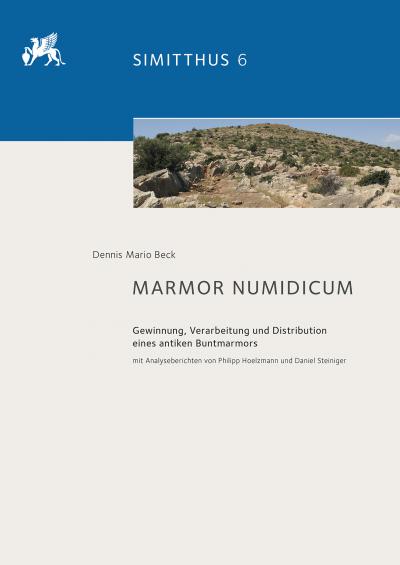- Dennis Mario Beck [Author] https://orcid.org/0000-0002-6105-1333 Rheinische Friedrich-Wilhelms-Universität Bonn [https://ror.org/041nas322]
- Philipp Hoelzmann [Chapter Author] https://orcid.org/0000-0001-8709-8474 Freie Universität Berlin [https://ror.org/046ak2485]
- Daniel Steiniger [Chapter Author] https://orcid.org/0000-0002-5076-5605 Deutsches Archäologisches Institut [https://ror.org/0503gdw52]
Published
April 26, 2024Series
Categories
Bibliographic Information and Reviews
Copyright (c) 2024 Deutsches Archäologisches Institut
Marmor Numidicum, also known as Giallo antico, is one of the best known and most widespread colored marbles of antiquity, and was quarried in Simitthus, today Chimtou in Tunisia. The present study is a holistic interdisciplinary approach to marmor Numidicum and combines the results from different research disciplines. The basis is a collection of archaeological material for the recording of the spectrum of use and the distribution of the marble in the Mediterranean area from the 2nd century B.C. to the 3rd century A.D. Based on this dataset, conclusions are drawn in a diachronic perspective both on the marble extraction and chronology in the quarries and on the urban genesis as well as the use and distribution range of the marble. The results are correlated by means of comparisons with administrative structures and questions of ownership, too. The study presents a periodization and localization of all variants of the marble to their extraction areas, considering archaeometric analyses of samples from the quarries for the first time in research. Another aspect concerns the role of marmor Numidicum within ancient trade systems. In order to get closer to these perspectives, questions about extraction, actors in trade networks, transport and logistic issues are comparatively analyzed with the help of the spectrum of use and distribution in diachronic evaluations and contextualized in case studies with the model of the chaîne opératoire. Theories and models from New Institutions Economics are discussed, too. Regarding the use of the local marble, the study yielded the result that the city of Simitthus and its quarries formed an entangled unit over the periods studied. Thus, for one of the most important colored marbles of antiquity a single study is now available.
Keywords:
marbles, colored marbles, ancient economy, ancient marble trade, ancient marble decorations, materiality, ancient quarriesChapters










 Stumble It!
Stumble It!

No comments:
Post a Comment